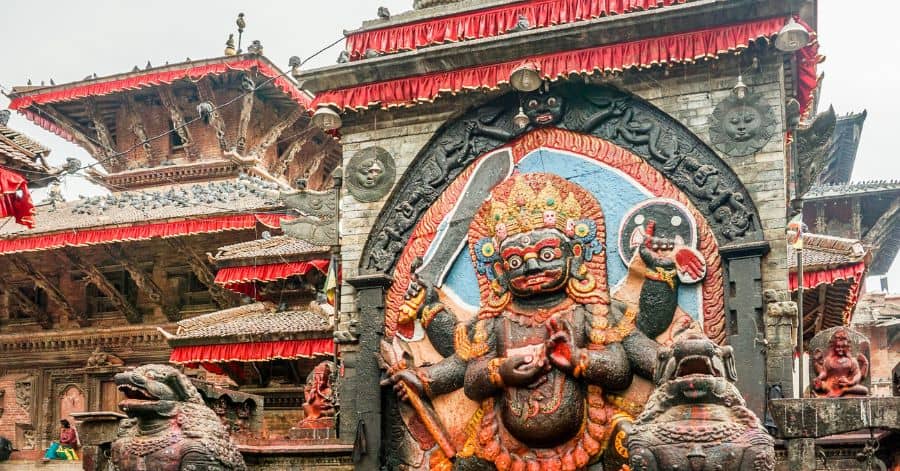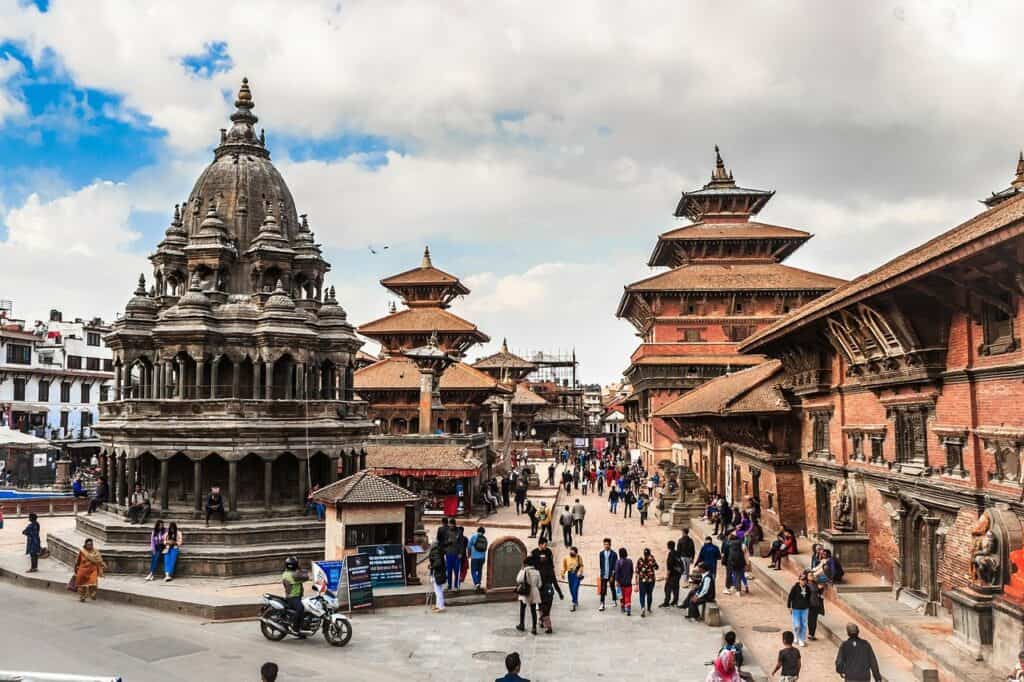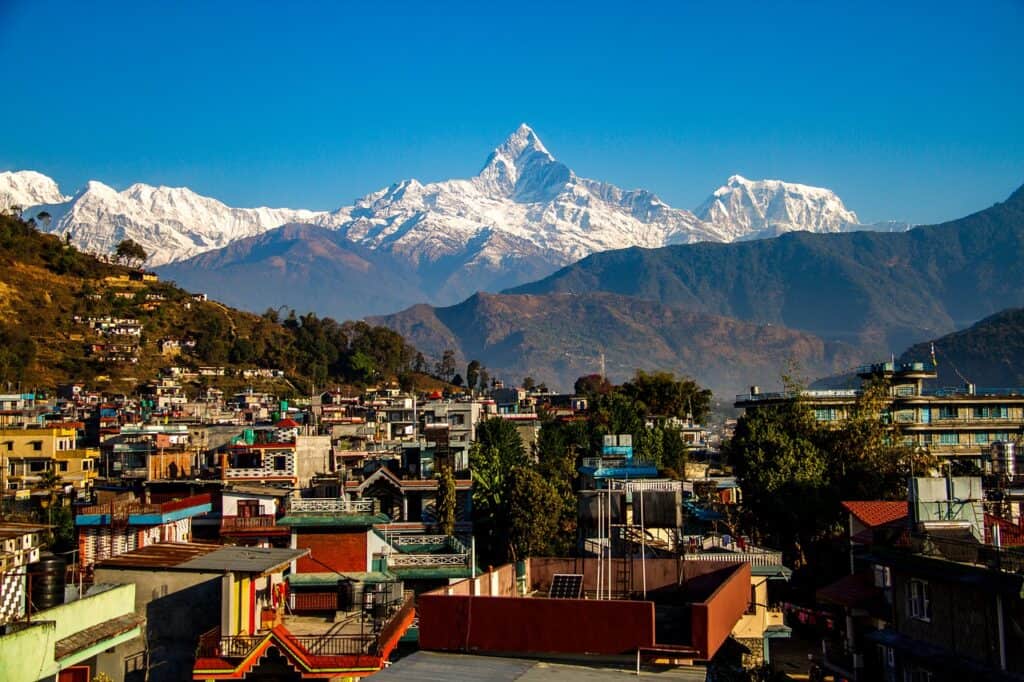South Asia, in general, has lots of festivals and celebrations. You have likely heard of Chinese New Year, Diwali, and Songkran. Nepal and India, among other South Asian countries, celebrate festivals yearly.
While Nepal shares Hindu festivals similar to those in India, it has several more festivities. Festivals in Nepal are more than mere celebrations; they pay homage to multiple Nepali cultures, ethnicities, communities, minorities, and religions. They are a medium for diverse communities to unite and co-exist in harmony and a peaceful environment.
That being said, it is quite challenging to list Nepali festivals, as there are way too many. Nonetheless, we present you with some of the major festival celebrations in Nepal.
Also Read:
Major Hindu Festivals
Nepal was initially a Hindu nation before being declared secular in 2015. Moreover, out of a total population of 29 million, 81.3% of people follow Hinduism. So, most of Nepal’s festivals are associated with the Hindu religion.
Dashain
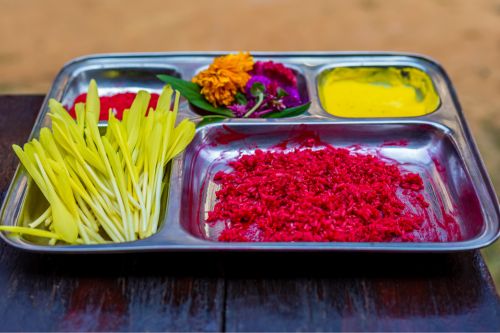
- Start Date: October 15, 2024
- End Date: October 28, 2024
- Location: Celebrated in almost all regions of Nepal
Dashain is the biggest Hindu festival, celebrated for fifteen days, starting from Shukla Paksha in Ashwin (September or October). The first ten days involve worshipping gods and goddesses, visiting temples, cleaning houses, buying clothes, receiving tikas, etc. The last five days involve visiting relatives’ houses and fasting.
Dashain symbolizes good’s victory over evil. This is manifested in Goddess Durga’s victory over the demon Mahishasura and Lord Ram’s win against Ravana. In Nepal, Dashain is the time to visit parents and ancestral homes. Little children often look forward to buying new clothes and shoes at this time of the year.
The festival starts with Ghatasthapana, a day to sow sacred grass, Jamara. The following days don’t include grand festivities until Phulpati on day 7. At that time, a Phulpati procession is carried out to the Kathmandu Durbar Square. Nepali Army also holds a grand ceremony in Tudhikhel.
Day 8 and Day 9 see ritual sacrifices to Goddess Kali. Hanuman Dhoka’s Taleju temple is full of Hindu devotees. Finally, the 10th day is Bijaya Dashami, when families gather, and elders put tika and jamara on youngsters’ foreheads. Afterward, people visit relatives’ houses or enjoy their remaining holidays.
Check These Handpicked Activities:
Tihar
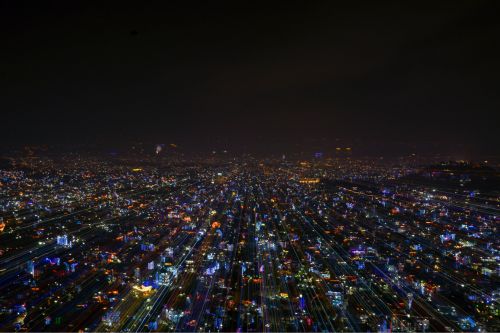
- Start Date: November 3
- End Date: November 6
- Location: Celebrated in Kathmandu Valley and Hilly Region
Tihar or Deepawali is the second biggest Hindu festival after Dashain and often falls on Ashwin or Kartik. It is also called the Festival of Lights and lasts for five days. People decorate their houses with diyos, fairy lights, and twinkling decorations. Although it is banned, many still light firecrackers at night.
Deepawali’s first day is Kaag Tihar, which is dedicated to worshipping messenger crows. The second-day honors dogs and their loyal nature. Furthermore, Tihar’s third day is Lakshmi puja, when people worship the wealth goddess Laxmi. People also worship cows during the morning.
Tihar’s fourth day is Govardhan puja, when people worship oxen and Govardhan mountain. The Newari Hindus also celebrate Mha puja, where Newars worship themselves. Finally, Bhai Tika comes on the fifth day. Sisters put seven colored tikas on their brothers’ foreheads, praying for longevity.
Likewise, brothers reciprocate by putting tikas on sisters’ foreheads and touching their feet. Bhai Tika symbolizes love, respect, and a strong bond between siblings. After the fifth day, Nepali offices often issue an additional day off for rest.
Janai Purnima
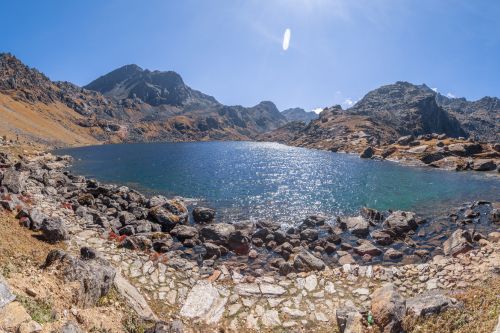
- Start Date: August 19
- End Date: August 19
- Location: Celebrated in Kathmandu, Rasuwa, Dolkha, and Hilly Region
Janai Purnima holds significant importance among Hindu men. Brahmin and Chhetri males primarily receive their first janai during childhood after a ritual or puja. This sacred thread symbolizes their journey to manhood and protects them from evil. Furthermore, they wear this janai throughout their lives, changing it annually in Shrawan after bathing in rivers or ponds.
This festival is also for the families. For instance, kids and women receive doras from priests. Many families visit shrines and pilgrimage sites like Gosaikunda, Kumbheswar, and Charikot. They consume a specially made soup called Kwati.
Many people also celebrate Raksha Bandhan on the same day. Sisters tie rakhis around their brothers’ wrists, praying for their health. Initially an Indian festival, it has also gained popularity in Kathmandu Valley and other regions.
Check These Handpicked Activities:
- Amazing Short Gosaikunda Trek from Kathmandu Nepal
- Gosaikunda Private Helicopter Tour from Kathmandu
Krishna Janmashtami and Nag Panchami
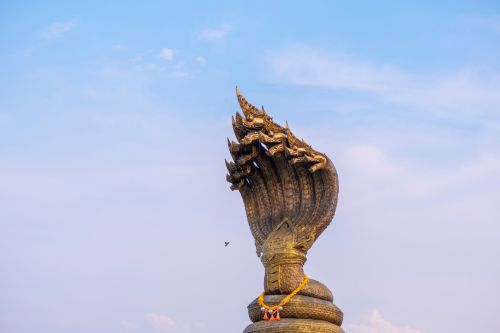
- Start Date: August 26
- End Date: August 26
- Location: Celebrated in Kathmandu, Hilly, and Terai Region
The Hindu religion has many deities, including the Trimurti: Brahma, Bishnu, and Shiva. Lord Krishna is Shiva’s son and Bishnu’s 8th avatar. He is a supreme God with millions of devotees worldwide. And Krishna Janmashtami is a celebration of Krishna’s birthday.
It falls on the eighth day of Krishna Paksha. This festival is widely celebrated in Nepal by organizing religious programs, prayers, dances, and plays. Many women fast on this occasion and only break it at midnight. Likewise, devotees visit Krishna temples, shrines, and pilgrimage sites. Patan’s Krishna Mandir is full of people at that time of the year.
On the other hand, Nag Panchami falls on Shrawan (July/August) and is associated with Lord Krishna. Legend says this festival marks Krishna’s victory over Kaliya Nag. Other tales say Nagas once halted rain in Nepal and didn’t let go until that period’s King made them do so. The latter then started the tradition of worshipping snakes.
In modern times, Hindus paste snake pictures on doorways and walls of their houses. They visit shrines and worship serpent deities. Some also feed milk to the snakes and pour milk outside their holes. Fasting is another way of celebrating Nag Panchami.
Hartalika Teej
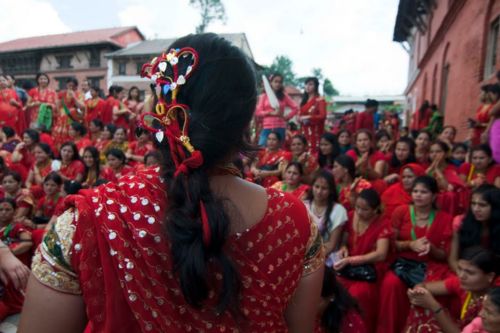
- Start Date: September 6
- End Date: September 8
- Location: Celebrated in Kathmandu and Hilly Region
Hinduism has always pushed the concept of Pativrata (devotion to one’s husband). While many might consider it a patriarchal view, this virtue has been taught and passed down for generations. Hartalika Teej is linked with this concept. It sees married women fasting and praying for their husbands’ longevity and welfare.
Teej falls on Bhadra or Ashwin (August or September) annually. It is a women’s festival that worships Lord Shiva. Furthermore, this festival commemorates Parvati’s wish to marry Shiva; many unmarried girls fast, wishing for a perfect groom or a good husband like Shiva.
On the other hand, married women visit their parents’ houses to celebrate Teej. They fast for a whole day without water, praying for their husbands’ long lives. Moreover, women visit Shiva temples, shrines, and pilgrimage sites. They dress in red saris and kurtas and partake in dances.
Check These Handpicked Activities:
- Kailashnath Doleshwor Mahadev Tour In Kathmandu
- Maratika Cave “Halesi Mahadev” – 2 Nights 3 Days Jeep Tour
Maha Shivaratri
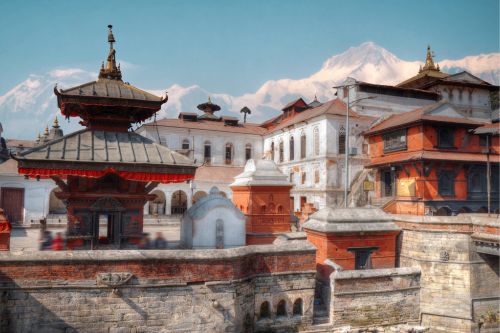
- Start Date: March 8
- End Date: March 9
- Location: Celebrated in almost all regions of Nepal, primarily in Kathmandu and Terai Region
If you visit Nepal in Falgun (February – March), you will see a celebration like never before. We are talking about Maha Shivaratri, a grand wedding celebration of Lord Shiva and Parvati. This day also commemorates Shiva’s victory over all of his enemies.
As its name suggests, Shivaratri is a nightlong celebration where devotees stay awake the whole night. They chant prayers, dance, sing songs, and meditate. Additionally, people light bonfires as a sign of farewell to the winter and welcome the summer.
Nepal’s Pashupatinath is full of people at this time of the year. Hindu devotees from worldwide visit this pilgrimage site. Moreover, sadhus and yogis start living in the temple a month prior and engage in festivities. Overall, Shivaratri is a grand festival and holds a massive spiritual significance.
Check These Handpicked Activities:
- Pashupatinath Aarati Trip from Kathmandu
- Pashupatinath and Doleshwor Mahadev Temple Darshan Tour from Kathmandu Nepal
Swasthani Brata
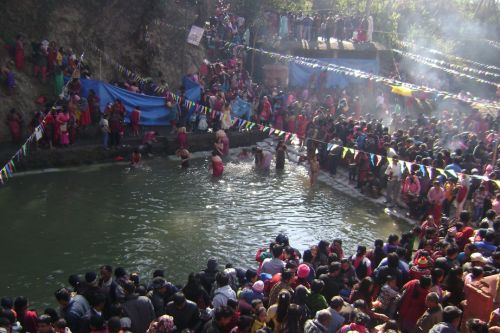
- Start Date: January 26
- End Date: February 24
- Location: Celebrated in Kathmandu, Sankhu, and Hilly Region
Hinduism has many festivals where fastings occur; however, Swasthani Brata is the only festivity with a month-long fast. It starts from Poush Shukla Purnima and ends in Magh Shukla Purnima. Devotees worship Goddess Swasthani and pray for fortune and welfare.
People who fast can only eat one meal a day. The foods have to be saltless and can’t be cooked by others. Also, the food items are rice, peas, beaten rice, ghee, sugar, fruits, and molasses. Furthermore, a family member must recite one chapter of Swasthani’s book daily. Others gather around him/her and listen to the story.
At the end of the Barta, women have to make 108 sel rotis, 108 fruits, 108 betel nuts, 108 flowers, and more. She must give 8 of each item to her husband or son. She must release them on the nearby river if no such person exists.
Swasthani Brata carries significant importance among the Hindus. They also visit several Shiva temples and shrines during the month-long celebration. Speaking of which, Sankhu’s Sali Nadi Temple is full of pilgrims.
Holi
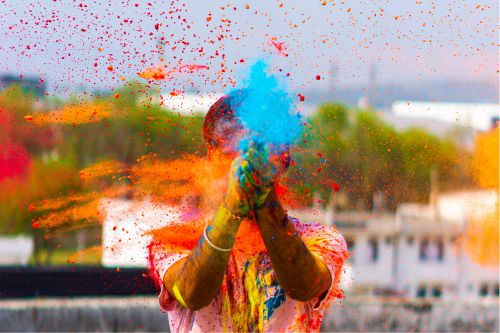
- Start Date: March 24 (Kathmandu), March 25 (Terai)
- End Date: March 24 (Kathmandu), March 25 (Terai)
- Location: Celebrated in Kathmandu, Pokhara, and Terai Region
Holi is primarily celebrated in Kathmandu Valley and Terai region. Although anyone can celebrate Holi, it is a Hindu festival. It has become a way for people of diverse cultures to unite and enjoy festivities.
This festival commemorates the end of Hiranyakashipu’s sister, Holika. She tried to burn her nephew Prahlada in a fire but ended up dead from the blazing flames. Hence, people light bonfires at night, symbolizing the good’s triumph over evil.
Another tale says Holi commemorates Krishna and Radha’s divine love. There is also a tale of Kamadeva and Rati’s love. All legends point to Holi’s significance as good’s victory over evil.
Furthermore, Nepalese people celebrate Holi by putting colors on one another’s faces. They also engage in various water activities, such as drenching each other with water and playing with water guns. Additionally, people consume many traditional dishes such as malpuas and gujiya.
Check This Handpicked Activity:
Newar Festivals
Many might know, but Newar has many ethnicities, religions, and cultures. For instance, Newar Hindus, Newar Buddhists, and Newar Christians exist. Likewise, their festivals vary from those of Hindus and last throughout the year. There is a saying, Bahun bigryo moj le, Newar bigryo bhoj le, meaning Newars’ feasts and celebrations take up most of their earnings and time.
Biska Jatra
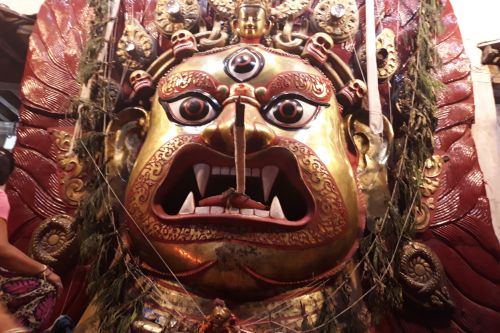
- Start Date: April 13
- End Date: Nine Days After Starting
- Location: Celebrated in Thimi and Bhaktapur
We can never complete our article without mentioning the dangerous festival Biska Jatra. It is primarily celebrated on Bhaktapur and Thimi for nine days and eight nights and falls in mid-April.
The Jatra’s fascinating event should be the tug of war. Thousands of people pull a single chariot (lingo) from two directions. The side that wins will lead the lingo in their direction. However, this chariot pulling is very risky and has seen many casualties over the years. Sadly, some people have even died in the cases of lingo’s falling.
Another crazy festivity is Sindoor Jatra, where people smear sindoor on each other’s faces and bodies, like in Holi. They lead a 32-chariot procession by singing and dancing. Furthermore, there is a practice of tongue piercing in Biska Jatra. A resident will pierce his tongue with an iron spike and roam the streets. Sounds fascinating, right?
Biska Jatra involves worshipping many deities throughout the eight nights and nine days. They offer wine, rice, meat, fish, lentil cake, and boiled eggs. Additionally, Newars host parties and get-togethers, inviting their relatives, in-laws, and friends for meals.
Check These Handpicked Activities:
Indra Jatra
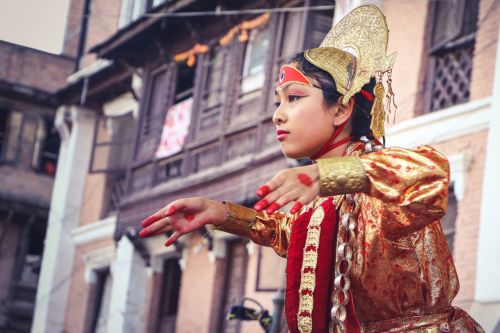
- Start Date: September 17
- End Date: 8 Days After Starting
- Location: Kathmandu, Patan, and Bhaktapur
If Biska Jatra is Bhaktapur’s grand festival, Indra Jatra is that of Kathmandu residents. It is an eight-day celebration on Bhadra (August – September). Devotees worship Lord Indra, thanking him for rainfall in the valley. It also honors Bhairav and the living goddess Kumari.
This festival starts with the erection of a ceremonial pole, Yasingh. Men drag this wooden pole through the Hanuman Dhoka Square. Then, the Kumari chariot procession begins, accompanied by masked dancers. Additionally, Bhairav’s masks are shown throughout the celebration.
People celebrate Indra Jatra by performing traditional dances like Pulu Kisi, Majipa Lakhey, Devi Pyakhan, Sawa Bhakku, and Mahakali Pyakhan. At the end of the festival, the erected Yasingh is pulled down and put to rest in Bagmati and Bishnumati.
Check These Handpicked Activities:
Saa: Paru/Gai Jatra
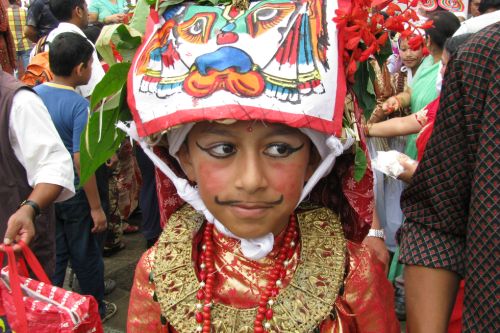
(Source: Wikimedia Commons)
- Start Date: August 20
- End Date: August 20
- Location: Celebrated in Bhaktapur, Thimi, Lalitpur, and Kathmandu
Saa: Paru comes a day after Janai Purnima in Bhadra. It is a day to commemorate the memories of the deceased. Newar households that have lost their member in the past year lead a Gai Jatra procession through the streets of Bhaktapur Durbar Square. They often dress up as cows, so the festival is as renowned as Gai Jatra.
This festival’s origin dates back to King Pratap Malla’s regime. He ordered a Gai Jatra procession to console his grieving queen. Residents tried to make the queen smile with their ridicule and jokes. Hence, this festival is associated with comedy, and many comedy festivals, plays, and performances are organized in Kathmandu.
Gai Jatra will be a fun experience for any newcomer or visitor. They can participate in festivities and dances, including Ghintang Ghisi. I recommend readers visit Bhaktapur to get full enjoyment of Saa: Paru.
Rato Machindranath Jatra And Bhoto Jhatra
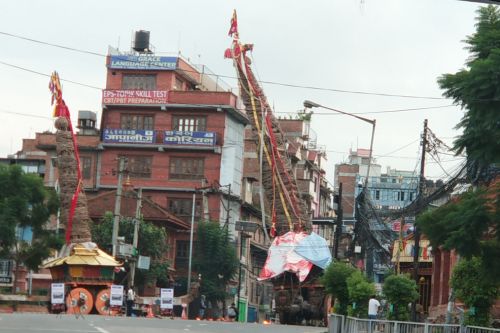
(Source: Wikimedia Commons)
- Start Date: March 9
- End Date: A month after starting
- Location: Celebrated in Patan/Lalitpur
Having discussed Kathmandu and Bhaktapur Newars’ festivals, let’s move on to Lalitpur/Patan Newar community’s celebration. Their biggest festival is Rato Machindranath Jatra, which falls on the 4th day of Bachhala. Also, Rato Machindranath temple is in Bungamati, Patan.
This is a grand celebration that lasts for an entire month. It begins with the construction of a 50-60 ft tall chariot. Then, Rato Machindranath’s statue is placed on the chariot and pulled through Natole, Gabahal, Sundhara, Kumaripati, and Jawalakhel streets.
Bhoto Jatra is the festival’s final stage after the chariot arrives in Jawalakhel. A Nepali governmental official will show Rato Machindranath’s black jewel-studded vest to people from the chariot. Thousands of people and Patan’s Kumari watched the event, and the festival ended.
Check These Handpicked Activities:
- Full day Sightseeing Kirtipur City of Glory Bungamati Khokana
- Excursion to Twin Villages: Bungamati & Khokana
Yomari Punhi
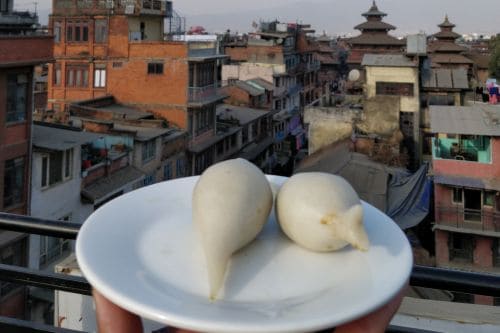
- Start Date: December 15
- End Date: December 15
- Location: Celebrated in Bhaktapur, Kathmandu, and Lalitpur
Yomari Punhi is another renowned Newari festival on Mangsir (November/December). It commemorates Parvati’s manifestation of Annapurna, thanking her for the rice harvest. Additionally, it is celebrated on every full moon of Mangsir.
Many people understand this festival by its delicacy, Yomari. It is a steamed rice flour dumpling made in a fish shape. They are super delicious and often come with chaku and khuwa fillings. Furthermore, Yomaris are primarily homemade and challenging to find in restaurants.
Newari people make and distribute Yomaris to their relatives, neighbors, and families. Interestingly, this Newari delicacy is associated with love and romance. In the past, people used to roam the streets and visit from house to house, asking for a Yomari. It was a kind of an excuse to meet their lovers.
Yomari Punhi is the only festival celebrated in the Newar community. If you visit Bhaktapur or Patan, try Yomaris from authentic Newari eateries.
Buddhist Festivals
Buddhists hold the second largest population in Nepal, with 9%. Indigenous groups like Gurungs, Tamangs, Yakkhas, and Magars follow Buddhism. It is more than a religion rather, Buddhism is a way of living by adopting Buddha’s eight teachings. Additionally, Nepal’s Theravada, Newar Vajrayana, and Tibetan Vajrayana Buddhism exist.
Buddha Jayanti
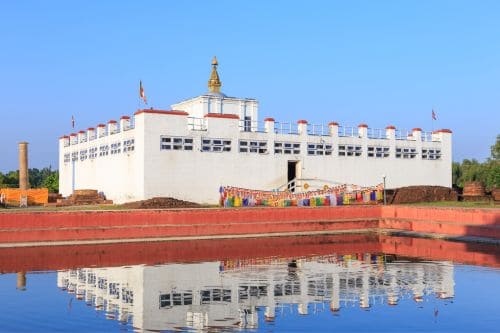
- Start Date: May 23
- End Date: May 23
- Location: Celebrated in Kathmandu and Lumbini
Nepal takes pride in being the birthplace of Lord Buddha. He was born Siddhartha Gautam in Lumbini of Rupandehi District in the 6th or 5th Century. Moreover, Gautam spent his life as a religious teacher and traveled around northwest India, accepting disciples and spreading his teachings.
Unlike Hinduism, Buddhism has limited festivals, among which Buddha Jayanti falls annually on the Baisakh Purnima (April or May). It is a grand celebration as Nepali Buddhists start their day by visiting Buddhist stupas and monasteries.
This festival commemorates Lord Buddha’s three important phases in life, i.e., birth, enlightenment, and Nirvana. Legend says all these things happened on the same day of Buddha’s life. It comes soon after the Nepalese New Year and is a public holiday.
Furthermore, people celebrate Buddha Jayanti by visiting Buddha shrines, performing puja, and participating in processions. Kathmandu residents visit Swayambhunath Temple, Boudhanath, Mahabouddha Temple, and other stupas. Many cultural programs and ceremonies are also organized on this day.
If you want to enjoy a truly festive environment, you must visit Lumbini. A grand chariot procession takes place in the town, accompanied by traditional dance, music, and prayers. Many oratory, essay writing, and poetry competitions also take place. Also, let’s not forget the annual Grand Buddha Jayanti fair that boasts thousands of devotees attendance.
Check These Handpicked Activities:
- Swayambhunath Buddhist Stupa Hiking from Thamel, Kathmandu
- Full Day Lumbini Tour
- 3 Hours Walking Tour at Swayambhunath
Lhosar Celebrations
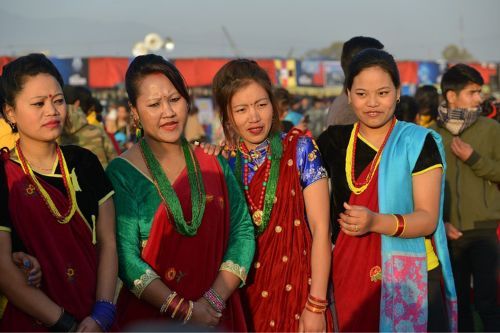
Nepali Buddhists celebrate Lhosars with grandeur. It symbolizes the New Year celebration of various ethnic groups such as Gurungs, Sherpas, Yakkhas, etc. The Nepal government has issued holidays on the occasion for these communities.
Tamu Lhosar
- Start Date: December 30
- End Date: December 30
- Location: Celebrated in Kathmandu, Gorka, Kaski, Tanahun, etc.
The Gurung community’s New Year, Tamu Lhosar, falls on Poush 15th of the Nepali calendar. They celebrate this festival with gusto, wearing Bhangra-Kachhad and Ghalek-Gunyo Cholo, participating in cultural programs, and enjoying a grand feast. Kathmandu residents attend events at Tudhikhel.
Gurungs symbolize bravery and courage and are primarily involved in the Gurkha Army and the British Army. They reside in Gorkha, Kaski, Syangja, Tanahun, Lamjung, and Kathmandu. Moreover, Tamu Lhosar allows the Gurungs to unite with their family and loved ones. Those living abroad return home to celebrate this festival.
Check These Handpicked Activities:
Sonam Lhosar
- Start Date: January 30
- End Date: January 30
- Location: Celebrated in Kathmandu, Langtang, and Nuwakot
This auspicious festival is the New Year celebration of the Tamangs. The celebration includes decorating houses, visiting stupas, engaging in prayer ceremonies, participating in cultural performances, exchanging greetings, sharing gifts, and enjoying feasts. The festivities don’t end until late at night.
Everyone can partake in the Sonam Lhosar celebration, including foreign visitors. If you are wondering where to go to enjoy this festival, many recommendations are available. For instance, you can celebrate Sonam Lhosar at Tudikhel, Kathmandu. Or, you can visit Swayambhunath, Langtang Valley, Nuwakot, Dhading, and Rasuwa.
Check These Handpicked Activities:
- Langtang Valley Trek
- Nuwakot Zipline – Explore Historical sites And Zipline
- Langtang Kanjin Gumba Trek
Gyalpo Lhosar
- Start Date: Two weeks before the main day on February 28
- End Date: February 28
- Location: Celebrated in Kathmandu and the Himalayan Region
This festival is the Sherpa community’s New Year celebration in Falgun (February/March). The two-week celebration begins with making a deep-fried Sherpa snack, Khapse. Then, the Sherpas consume nine bowls of specially made Gutung soup two days before the Lhosar. The soup comes with dumplings that often have hidden items like wood, coal, and salt.
A day before the main event, Sherpas cleaned and decorated their houses. At midnight, they exchange Tashi Delek, a traditional greeting, welcoming the Gyalpo Lhosar. Furthermore, the New Year celebration includes socializing, singing, dancing, eating, and drinking all day. People visit monasteries during the afternoon and end the festivity with a sumptuous dinner.
Nepali Indigenous People’s Festivals
Nepal is a home of diverse ethnic groups, communities, and tribes. Speaking of which, Nepalese Indigenous people make up 36% of the total population. Some of the major ethnic groups are Magar, Tamang, Rai, Thakali, Kirat, Jirel, Raute, Tharu, Rajbanshi, Dhimal, etc. They celebrate numerous festivals throughout the year.
Nwagi/Udhauli
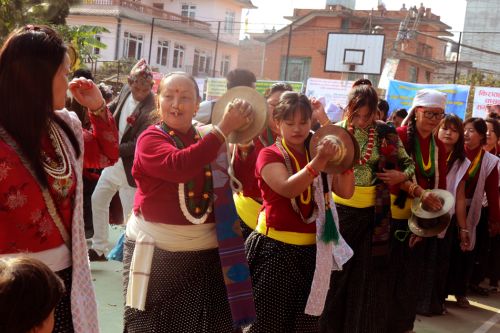
- Start Date: December 15
- End Date: December 15
- Location: Celebrated in Makwanpur, Parsa, and Eastern Region
Rai, Bankariya, and Chepang’s festival Nwagi is widely celebrated throughout Nepal. It is all about worshipping the ancestors and nature god, thanking them for the harvest. Furthermore, people offer their first harvest food to their ancestors before eating. It is done to avoid their curse.
Interstingly, Nwagi doesn’t have a fixed date, as it changes from family to family. The Kirat community celebrates Nwagi as Udhauli, marking their migration from the hills towards the lower region. They worship Mother Nature and perform the traditional dance, Sakela.
Makwanpur and Parsa’s Bankariya people celebrate Nwagi with grandeur. Visitors must travel to Makwanpur from late September to early October to see their festivity.
Siruwa
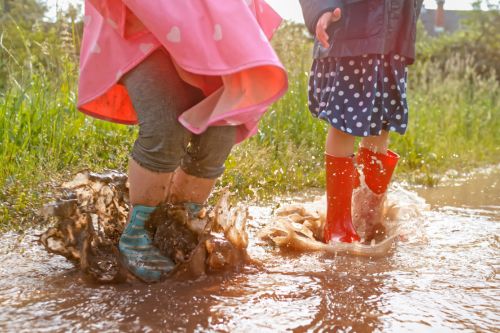
- Start Date: April 13
- End Date: April 15
- Location: Celebrated in the Terai Region
Nepal’s Terai region celebrates different festivals than the Hilly and Mountain regions. Siruwa, for example, is a unique way of celebrating Nepali New Year. Rajbhansi, Tharu, and Majhi people celebrate it for three days in mid-April.
This water festival is where elders sprinkle water on juniors as blessings on the first day. On the second day, Rajbhansis play mud, signifying their connection with the Earth. Finally, the last day involves playing with colors, much like Holi.
Jitiya Parva
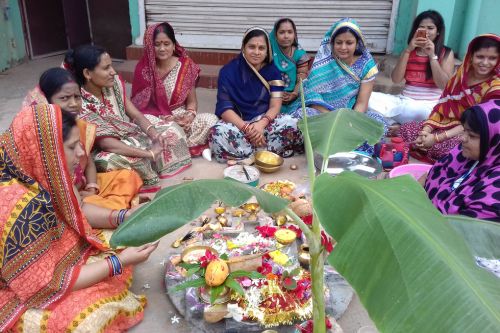
- Start Date: September 25
- End Date: September 27
- Location: Celebrated in the Terai Region
Jitiya is a Hindu festival celebrated in Nepal and India. The Tharu community primarily follows this tradition of observing fast without water. Married women fast to wish for the prosperity and welfare of their kids, husbands, and family.
This fasting ritual occurs on Dashain’s 7th, 8th, and 9th days. Women fast during the daytime on the first day. They take a 24-hour fast on the second day and end it on the final/third day. They also worship Jitmahan and listen to Jitiya stories.
Chhath Puja
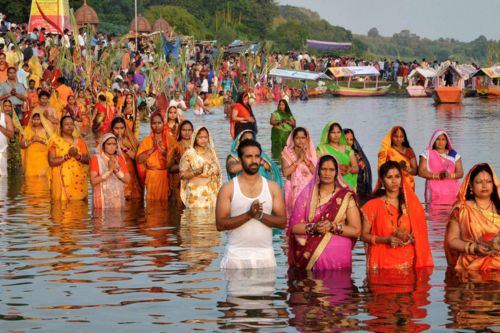
(Source: Wikimedia Commons)
- Start Date: November 7
- End Date: November 8
- Location: Celebrated in the Terai Region
This is a 4-day long Hindu festival that comes six days after Tihar. The Tharu community primarily participates in this festivity by fasting. Moreover, Chhath puja commemorates the Sun God, thanking him for sustaining life on Earth.
On the first day, women begin their days by taking holy baths before sunrise. They consume Kaddu-Bhat on the day and abstain from other meals. The devotees fast for a whole day on the second day.
On the third day, people gather at riverbanks with thekua, fruits, sugarcane, and other offerings and pray to the setting sun. On the final day, they bid farewell to the sun god and break their fast. They also share Prasad with family members and neighbors.
Kathmandu’s Rani Pokhari is full of devotees during the time of Chhath. Likewise, Janakpur’s Janaki Temple and Birgunj are full of pilgrims.
Check These Handpicked Activities:
- Janakpur 2 days 1 night Tour from Kathmandu
- Kathmandu Cultural Journey – Day Trip | Kathmandu Valley Sightseeing Tour
Ladi Puja
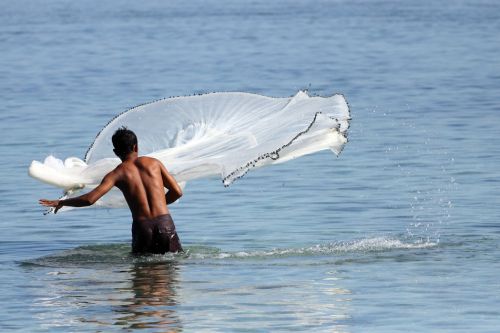
- Start Date: May 4
- End Date: May 4
- Location: Celebrated in Malghunga, Parbat, and Baglung
Nepal’s Majhi community relies on fishing, animal husbandry, and agriculture for survival. As fishing is their main occupation, they worship and treat the river as their god. Ladi puja, hence, is the tradition of water worship.
This is Majhi people’s biggest festival that falls on Falgun after Maha Shivaratri. They offer fishing nets, agricultural tools, and sacrifices while worshipping the Water God. They also worship 33 crore Hindu deities. Finally, Ladi Puja is done to ask for protection and safety in the river.
Gaura Parva
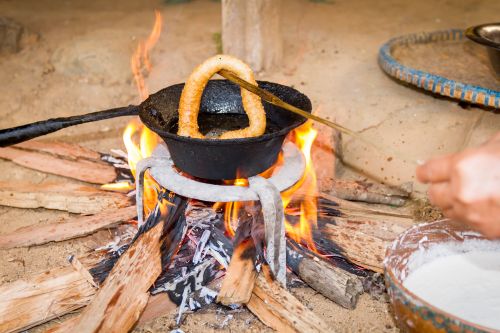
- Start Date: August 26
- End Date: August 26
- Location: Celebrated in Doti, Karnali and Far-Western Region
This is another Hindu festival celebrated in Karnali, Doti, and Far-Western province. It commemorates Parvati, aka Gauri, and Lord Shiva’s marriage. Moreover, the Khas community primarily observes fasts during this auspicious occasion. The festivity lasts for four to five days.
Married women fast throughout the day during Gaura. They abstain from garlic, onion, and meat and only consume sel roti, kheer, and puri at the end of the day. Furthermore, both men and women engage in cultural programs, dances, and events. They wear traditional dresses and sing traditional songs like Deuda.
Toran-La
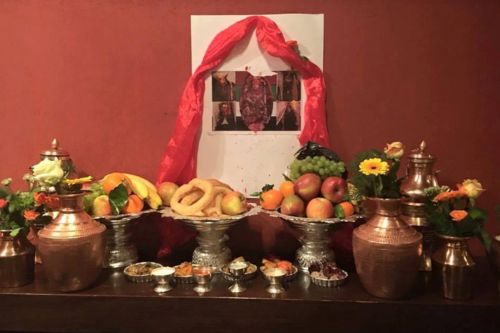
- Start Date: March 23
- End Date: March 25
- Location: Celebrated in Myagdi and Mustang
Thakali festival Toran-La is celebrated on the same day as Holi; however, it is celebrated differently as it includes worshipping ancestors and forefathers. It also includes cleaning houses, donning new attires, family gatherings, cooking delicacies, participating in archery, and playing cards.
The Thakali women cook Khimi, which is made up of alcohol, ghee, milk, and chhyang, and offer it to their ancestors. Brothers often invite their married/unmarried sisters and in-laws for get-togethers. Furthermore, men compete in archery, and women play cards during the daytime. All in all, Toran-La is celebrated for three days and three nights.
Islamic Festivals
In the present context, Islamaphobia has been a burning issue worldwide. Thankfully, Nepal is a secular state that supports equality, harmony, and peaceful co-existence of people of diverse cultures, religions, and ethnicities. As such, Nepal Muslims have access to facilities as much as other religions. This also includes their right to celebrate festivals.
Eid al-Adha
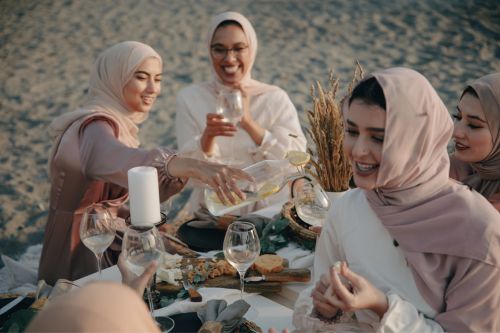
- Start Date: June 16
- End Date: June 17
- Location: Celebrated in Kathmandu and the Muslim community
When discussing Muslim festivals, we can’t leave Eid al-Adha. It is a celebration of Ibrahim’s devotion to God. His devotion and obedience towards God led him to sacrifice his son Ishmael willingly. This festival teaches Muslims to sacrifice their everything, including desires and ego to please Allah.
Eid al-Adha is a festival of sacrifice, paying homage to Ibrahim’s readiness to sacrifice his child. To honor his willingness, Muslims sacrifice sheep, goats, camels, cows, and bulls. They share the meat with their friends, relatives, and families. Additionally, they share a portion with needy and poor people.
Eid al-Fitr
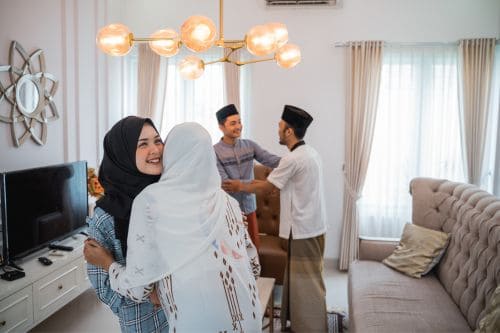
- Start Date: April 9
- End Date: April 10
- Location: Celebrated in Kathmandu and the Muslim Community
Nepali Muslims’ biggest festival is Eid al-Fitr, which marks the end of Ramadan. The latter is a month-long fasting custom on the Islamic Calendar’s ninth month. Furthermore, devotees abstain from alcohol, cigarettes, sexual activity, and impure thoughts. They observe Roza from dawn to dusk.
Finally, Muslims break their month-long fast on Eid al-Fitr. People usually get up early, take baths, and visit mosques for Namaaz. They break their fast and enjoy a sumptuous meal of Eid delicacies like Biryani, Kebab, and Chicken. Additionally, devotees spend their day meeting and exchanging greetings with relatives and friends.
Eid ul-Fitr is also about providing food to needy and poor people. As such, they must make a compulsory donation before prayers at the festival. This is done to allow those in poverty to celebrate Eid. The Islam prioritizes helping others with whatever you have.
Festivals in Nepal reflect Nepali culture, customs, traditions, and beliefs. These concepts have been practiced since ancient times and passed from generation to generation. Moreover, festival celebrations have become a way for people to unite and enjoy each other’s company.
Festivals also break caste and religion barriers and promote equality and non-discriminatory society. Nepalese people celebrate many festivals throughout the year. Yet, each festivity strives to promote harmony and unity among them.
